Abstract
A cross-sectional study of 178 asymptomatic contact lens wearers attending 10 contact lens practices in the west of Scotland was conducted over a 4 month period. The aims of the study were to identify specific microbial contaminants in lens cases, to determine the rate of contamination of such containers and to assess the value of the steps involved in different lens care regimens in the prevention of case contamination. Microbial contamination affected 53% of lens cases. Cases used with conventional wear and disposable systems were contaminated at similar rates and, therefore, the advantage of regular lens replacement may have been lost if these lenses were stored in contaminated cases. Four percent of lens cases were contaminated with amoebal species and all of these showed concomitant bacterial colonisation. These findings imply that case hygiene is probably as important as lens hygiene if new or disinfected lenses are not to be immediately re-contaminated by storage in dirty cases. Unfortunately simple and effective methods of lens and case disinfection, which would be suitable for use in the average home environment, are not yet available. It follows that frequent and regular disposal of lens cases may prove to be a necessary measure to prevent the build-up of microbial colonisation in such containers.
Full text
PDF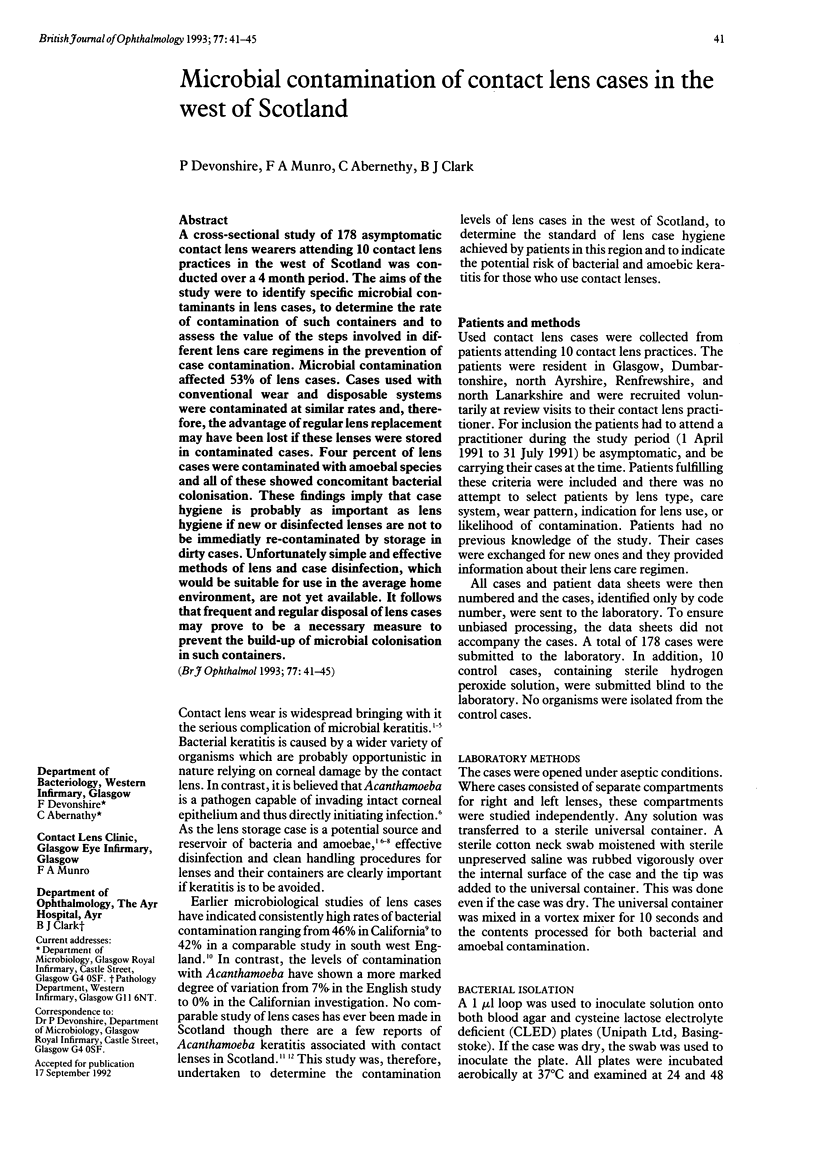
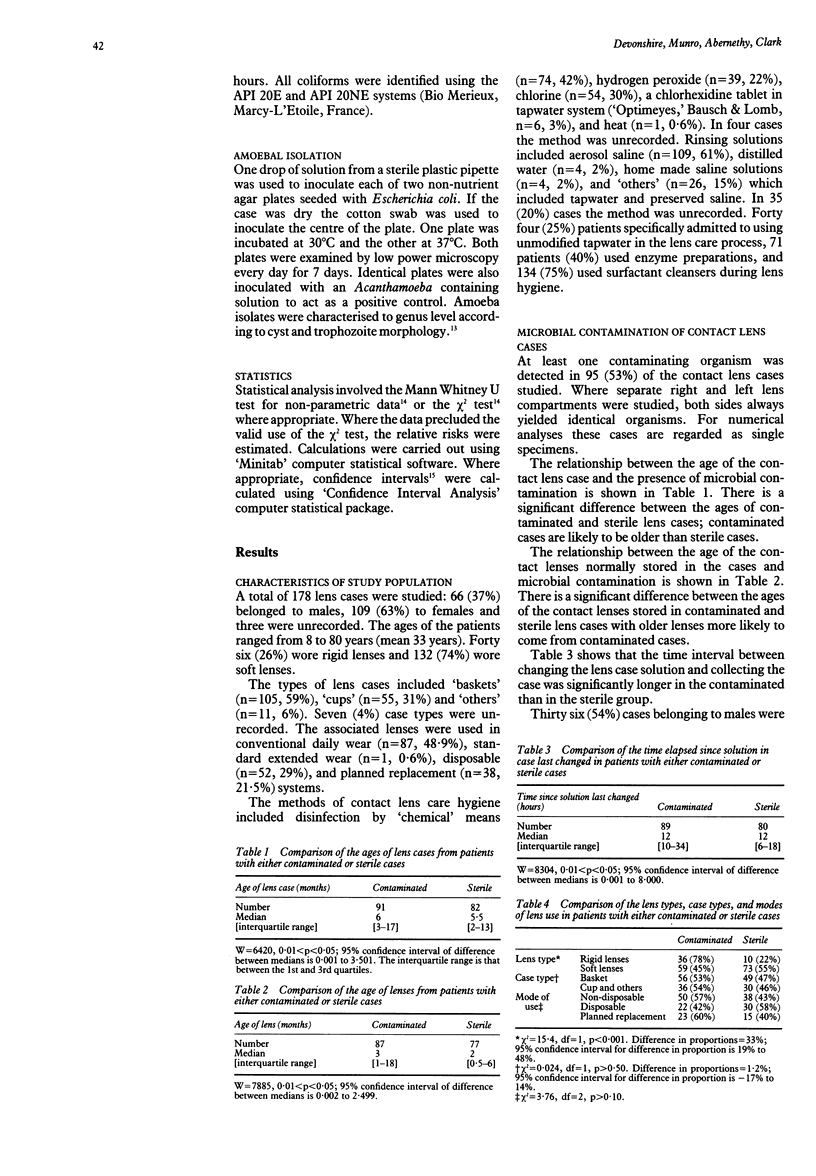
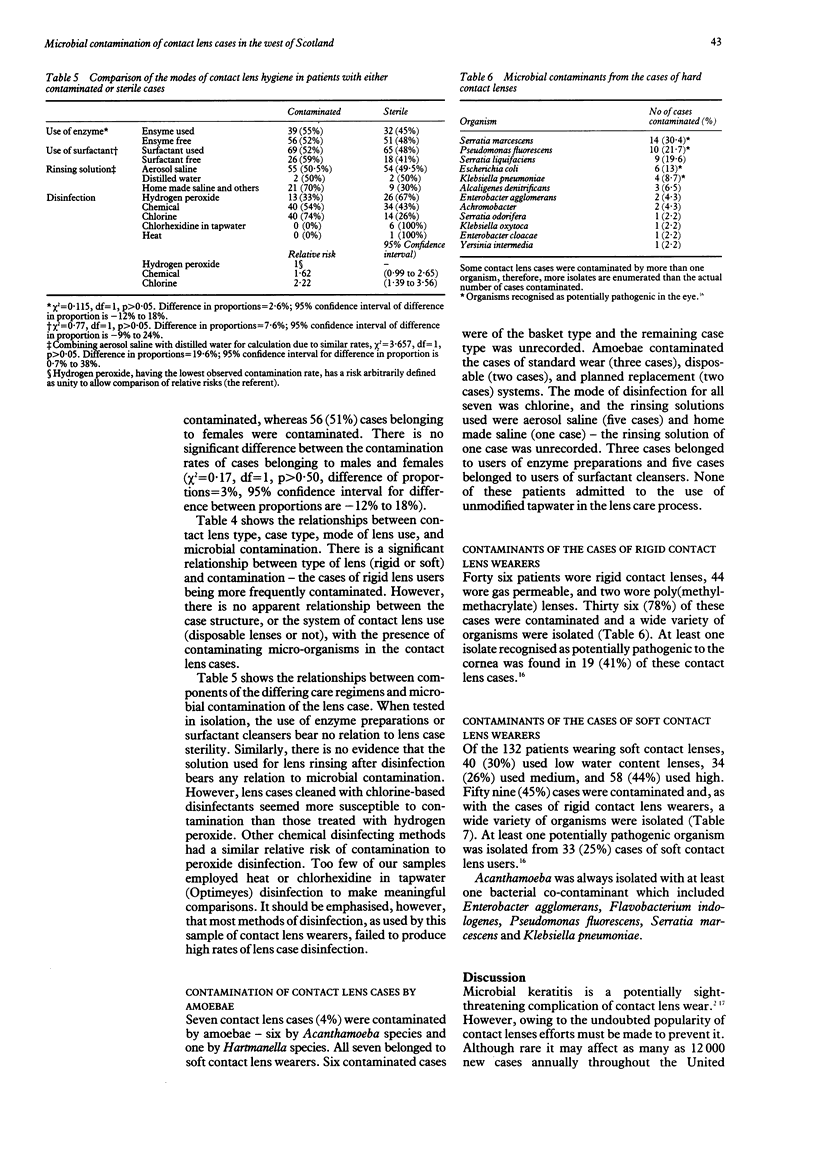
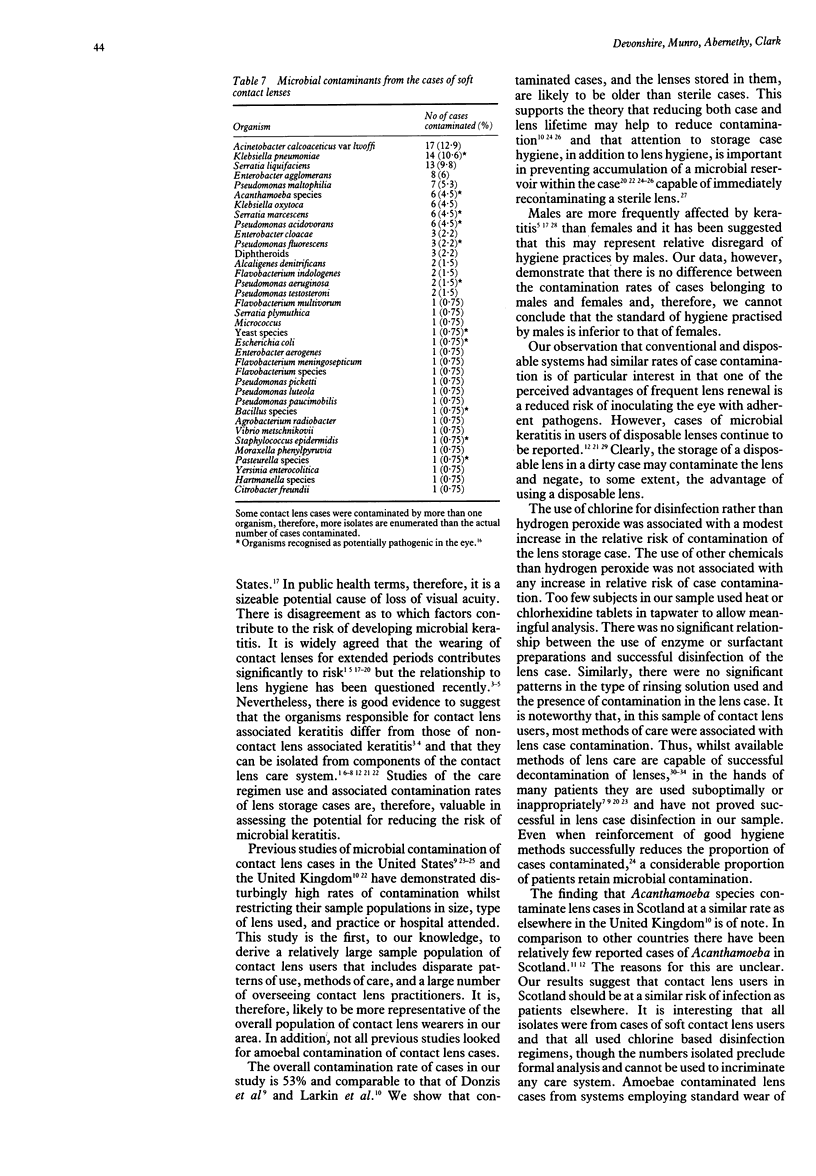
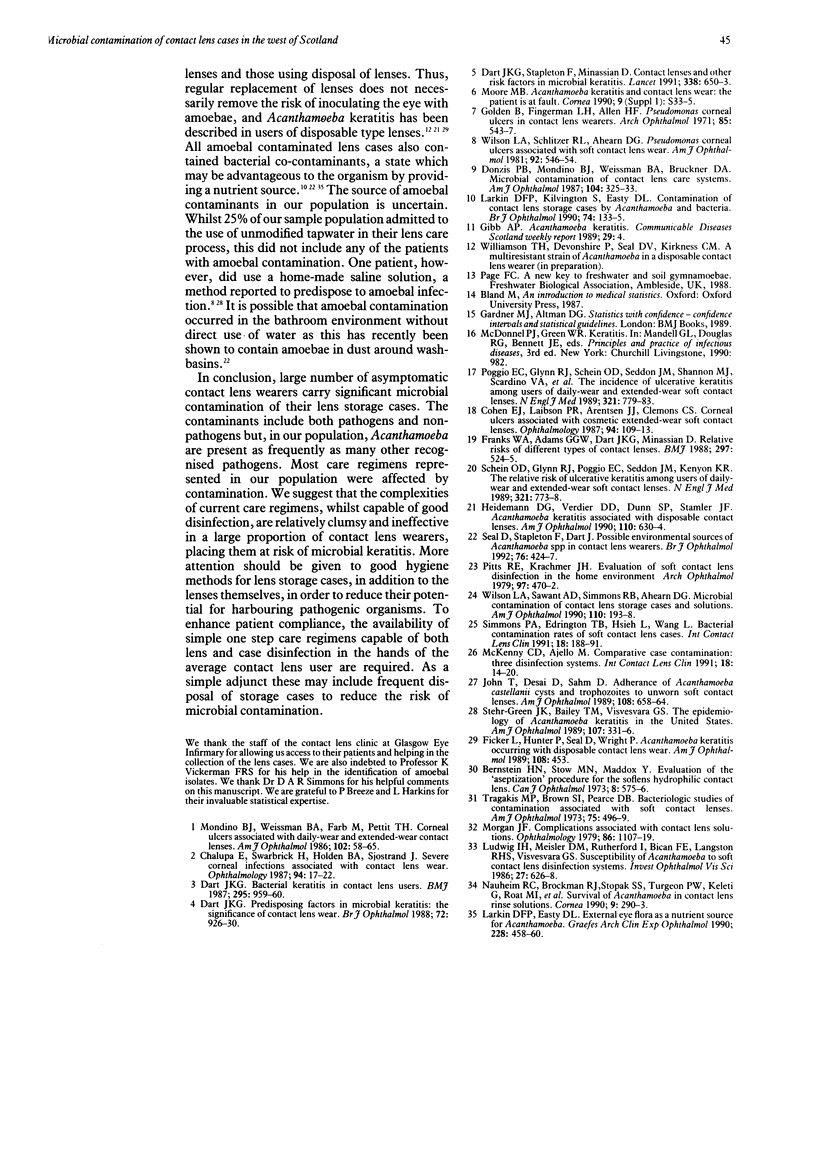
Selected References
These references are in PubMed. This may not be the complete list of references from this article.
- Bernstein H. N., Stow M. N., Maddox Y. Evaluation of the "aseptization" procedure for the Soflens hydrophilic contact lens. Can J Ophthalmol. 1973 Oct;8(4):575–576. [PubMed] [Google Scholar]
- Chalupa E., Swarbrick H. A., Holden B. A., Sjöstrand J. Severe corneal infections associated with contact lens wear. Ophthalmology. 1987 Jan;94(1):17–22. doi: 10.1016/s0161-6420(87)33513-4. [DOI] [PubMed] [Google Scholar]
- Cohen E. J., Laibson P. R., Arentsen J. J., Clemons C. S. Corneal ulcers associated with cosmetic extended wear soft contact lenses. Ophthalmology. 1987 Feb;94(2):109–114. doi: 10.1016/s0161-6420(87)33491-8. [DOI] [PubMed] [Google Scholar]
- Dart J. K. Bacterial keratitis in contact lens users. Br Med J (Clin Res Ed) 1987 Oct 17;295(6604):959–960. doi: 10.1136/bmj.295.6604.959. [DOI] [PMC free article] [PubMed] [Google Scholar]
- Dart J. K. Predisposing factors in microbial keratitis: the significance of contact lens wear. Br J Ophthalmol. 1988 Dec;72(12):926–930. doi: 10.1136/bjo.72.12.926. [DOI] [PMC free article] [PubMed] [Google Scholar]
- Dart J. K., Stapleton F., Minassian D. Contact lenses and other risk factors in microbial keratitis. Lancet. 1991 Sep 14;338(8768):650–653. doi: 10.1016/0140-6736(91)91231-i. [DOI] [PubMed] [Google Scholar]
- Donzis P. B., Mondino B. J., Weissman B. A., Bruckner D. A. Microbial contamination of contact lens care systems. Am J Ophthalmol. 1987 Oct 15;104(4):325–333. doi: 10.1016/0002-9394(87)90219-4. [DOI] [PubMed] [Google Scholar]
- Ficker L., Hunter P., Seal D., Wright P. Acanthamoeba keratitis occurring with disposable contact lens wear. Am J Ophthalmol. 1989 Oct 15;108(4):453–453. doi: 10.1016/s0002-9394(14)73319-7. [DOI] [PubMed] [Google Scholar]
- Franks W. A., Adams G. G., Dart J. K., Minassian D. Relative risks of different types of contact lenses. BMJ. 1988 Aug 20;297(6647):524–525. doi: 10.1136/bmj.297.6647.524. [DOI] [PMC free article] [PubMed] [Google Scholar]
- Golden B., Fingerman L. H., Allen H. F. Pseudomonas corneal ulcers in contact lens wearers. Epidemiology and treatment. Arch Ophthalmol. 1971 May;85(5):543–547. doi: 10.1001/archopht.1971.00990050545004. [DOI] [PubMed] [Google Scholar]
- Heidemann D. G., Verdier D. D., Dunn S. P., Stamler J. F. Acanthamoeba keratitis associated with disposable contact lenses. Am J Ophthalmol. 1990 Dec 15;110(6):630–634. doi: 10.1016/s0002-9394(14)77059-x. [DOI] [PubMed] [Google Scholar]
- John T., Desai D., Sahm D. Adherence of Acanthamoeba castellanii cysts and trophozoites to unworn soft contact lenses. Am J Ophthalmol. 1989 Dec 15;108(6):658–664. doi: 10.1016/0002-9394(89)90857-x. [DOI] [PubMed] [Google Scholar]
- Larkin D. F., Easty D. L. External eye flora as a nutrient source for Acanthamoeba. Graefes Arch Clin Exp Ophthalmol. 1990;228(5):458–460. doi: 10.1007/BF00927262. [DOI] [PubMed] [Google Scholar]
- Larkin D. F., Kilvington S., Easty D. L. Contamination of contact lens storage cases by Acanthamoeba and bacteria. Br J Ophthalmol. 1990 Mar;74(3):133–135. doi: 10.1136/bjo.74.3.133. [DOI] [PMC free article] [PubMed] [Google Scholar]
- Ludwig I. H., Meisler D. M., Rutherford I., Bican F. E., Langston R. H., Visvesvara G. S. Susceptibility of Acanthamoeba to soft contact lens disinfection systems. Invest Ophthalmol Vis Sci. 1986 Apr;27(4):626–628. [PubMed] [Google Scholar]
- Mondino B. J., Weissman B. A., Farb M. D., Pettit T. H. Corneal ulcers associated with daily-wear and extended-wear contact lenses. Am J Ophthalmol. 1986 Jul 15;102(1):58–65. doi: 10.1016/0002-9394(86)90210-2. [DOI] [PubMed] [Google Scholar]
- Moore M. B. Acanthamoeba keratitis and contact lens wear: the patient is at fault. Cornea. 1990;9 (Suppl 1):S33–S40. doi: 10.1097/00003226-199010001-00014. [DOI] [PubMed] [Google Scholar]
- Morgan J. F. Complications associated with contact lens solutions. Ophthalmology. 1979 Jun;86(6):1107–1119. doi: 10.1016/s0161-6420(79)35417-3. [DOI] [PubMed] [Google Scholar]
- Nauheim R. C., Brockman R. J., Stopak S. S., Turgeon P. W., Keleti G., Roat M. I., Thoft R. A. Survival of Acanthamoeba in contact lens rinse solutions. Cornea. 1990 Oct;9(4):290–293. [PubMed] [Google Scholar]
- Pitts R. E., Krachmer J. H. Evaluation of soft contact lens disinfection in the home environment. Arch Ophthalmol. 1979 Mar;97(3):470–472. doi: 10.1001/archopht.1979.01020010220005. [DOI] [PubMed] [Google Scholar]
- Poggio E. C., Glynn R. J., Schein O. D., Seddon J. M., Shannon M. J., Scardino V. A., Kenyon K. R. The incidence of ulcerative keratitis among users of daily-wear and extended-wear soft contact lenses. N Engl J Med. 1989 Sep 21;321(12):779–783. doi: 10.1056/NEJM198909213211202. [DOI] [PubMed] [Google Scholar]
- Schein O. D., Glynn R. J., Poggio E. C., Seddon J. M., Kenyon K. R. The relative risk of ulcerative keratitis among users of daily-wear and extended-wear soft contact lenses. A case-control study. Microbial Keratitis Study Group. N Engl J Med. 1989 Sep 21;321(12):773–778. doi: 10.1056/NEJM198909213211201. [DOI] [PubMed] [Google Scholar]
- Seal D., Stapleton F., Dart J. Possible environmental sources of Acanthamoeba spp in contact lens wearers. Br J Ophthalmol. 1992 Jul;76(7):424–427. doi: 10.1136/bjo.76.7.424. [DOI] [PMC free article] [PubMed] [Google Scholar]
- Stehr-Green J. K., Bailey T. M., Visvesvara G. S. The epidemiology of Acanthamoeba keratitis in the United States. Am J Ophthalmol. 1989 Apr 15;107(4):331–336. doi: 10.1016/0002-9394(89)90654-5. [DOI] [PubMed] [Google Scholar]
- Tragakis M. P., Brown S. I., Pearce D. B. Bacteriologic studies of contamination associated with soft contact lenses. Am J Ophthalmol. 1973 Mar;75(3):496–499. doi: 10.1016/0002-9394(73)91164-1. [DOI] [PubMed] [Google Scholar]
- Wilson L. A., Sawant A. D., Simmons R. B., Ahearn D. G. Microbial contamination of contact lens storage cases and solutions. Am J Ophthalmol. 1990 Aug 15;110(2):193–198. doi: 10.1016/s0002-9394(14)76991-0. [DOI] [PubMed] [Google Scholar]
- Wilson L. A., Schlitzer R. L., Ahearn D. G. Pseudomonas corneal ulcers associated with soft contact-lens wear. Am J Ophthalmol. 1981 Oct;92(4):546–554. doi: 10.1016/0002-9394(81)90649-8. [DOI] [PubMed] [Google Scholar]


